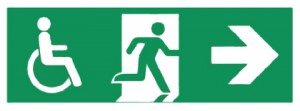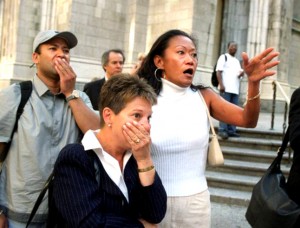2012-04-21: The context for considering and properly implementing Accessibility-for-All has changed … changed utterly … but some old problems persist, and stubbornly remain …
NEW INTERNATIONAL CONTEXT
A. At the time of writing, the United Nations Convention on the Rights of Persons with Disabilities (UN CRPD) has been ratified by 111 Countries and the European Union.
Concerning Accessibility of the Built Environment … UN CRPD Preamble Paragraph (g), and Articles 9 – 11 – 12 are the most immediately relevant. These texts can be easily found elsewhere on this BLOG … please use the ‘search’ facility at the top, right-hand corner of the WebPage.
With the innovative, and internationally accepted, understanding of ‘Accessibility’ – as distinct from ‘Access’ – contained in ISO 21542 : 2011 … the concept meaning: approach and entry to a building, circulation within and use of all the building’s facilities, egress from and removal from the building’s vicinity during normal circumstances, or evacuation in the event of an emergency and movement – via a safe and accessible route – to a place of safety which is remote from the building … it is now possible to deal with Fire Evacuation of Buildings through Article 9 (Accessibility) of the UN CRPD, where it is more in scale … more at home, so to speak … rather than through Article 11 (Situations of Risk & Humanitarian Emergencies), which had to be the case before.
B. ISO 21542: ‘Building Construction – Accessibility & Usability of the Built Environment’ … is the important new International Standard mentioned above. It was published in December 2011.
Ireland has no National Standard (or Code of Practice) on Accessibility. So, in the absence of an appropriate Harmonized European Standard, ISO 21542 must take precedence over the National Standards of any other European Union Member State.
Here, however, there is a very large fly in the ointment … the guidance text in the 2010 Technical Guidance Document M has been ‘lifted’, almost en masse, from a British National Standard on ‘Access’ … not ‘Accessibility’. And this flawed process has imported some serious errors into Irish Accessibility Design and Construction Practice … despite my warnings to the relevant authorities. Please refer back to this post , dated 2009-06-14.
Scope of ISO 21542 : 2011
ISO 21542:2011 specifies a range of requirements and recommendations for many of the elements of construction, assemblies, components and fittings which comprise the built environment. These requirements relate to the constructional aspects of access to buildings, to circulation within buildings, to egress from buildings in the normal course of events and evacuation in the event of an emergency. It also deals with aspects of accessibility management in buildings.
ISO 21542:2011 contains provisions with respect to features in the external environment directly concerned with access to a building or group of buildings from the edge of the relevant site boundary or between such groups of buildings within a common site. It does not deal with those elements of the external environment, such as public open spaces, whose function is self-contained and unrelated to the use of one specific building, nor does it deal with single family dwellings, other than those circulation spaces and fittings that are common to two or more such dwellings.
C. Of direct commercial interest within the European Union (and in any countries outside the EU who wish to trade with the EU and the European Economic Area) … Accessibility-Related Construction Products are now included in the framework of the (relatively) new European Union Regulation No.305/2011 of the European Parliament and of the Council, of 9 March 2011, laying down Harmonized Conditions for the Marketing of Construction Products and Repealing Council Directive 89/106/EEC. [The old EU Directive 89/106/EEC has been repealed … it is finished, it is gone, it is no more ! There will, however, be a suitable transition period from old to new.]
Construction Product (EU Reg.305/2011) means any product or kit which is produced and placed on the market for incorporation in a permanent manner in construction works or parts thereof and the performance of which has an effect on the performance of the construction works with respect to the basic requirements for construction works.
Construction Works (EU Reg.305/2011) means buildings and civil engineering works.
Basic Requirement for Construction Works No. 4 in Annex I of the new EU Regulation 305/2011, states the following …
Safety and Accessibility in Use
The construction works must be designed and built in such a way that they do not present unacceptable risks of accidents or damage in service or in operation such as slipping, falling, collision, burns, electrocution, injury from explosion and burglaries. In particular, construction works must be designed and built taking into consideration accessibility and use for disabled persons.
This is a suitable location for ‘Accessibility’ in Annex I … intimately connected to ‘Safety in Use’. However, there is one potential drawback. Specifying the level of safety in an EU Member State is the sole responsibility of the Authorities Having Jurisdiction (AHJ’s) in that Member State.
An Accessible Building is a Safer Building … but a Safe Building is not necessarily ‘Accessible’. ‘Accessibility’ is a completely different concept to ‘Safety’. EU Member States have no basis in EU Law … no justification whatever … for arbitrarily deciding on which level of ‘Accessibility’ is appropriate within their territories !
.
SAME OLD PROBLEMS
With all of this New International Context on Accessibility finally in place … I continue to encounter the same old problems …
1. Bad Product Design
An enormous quantity of cheap, atrociously designed … you could almost use the word ‘ugly’ … Accessibility-Related Construction Products are imported every year into Ireland, from Britain. This is one good reason, although not a very satisfactory reason, why architects hate ‘accessibility’ in buildings. Building users notice fittings and fixtures … and if the fittings and fixtures are ugly … the building is ugly ! But occupational therapists, for example, are also specifying these types of products every day of the week here.
This has got to stop. Proper attention must be paid to Good Design of Accessibility-Related Construction Products. An Accessible Building does not have to look like a Hospital Ward ! And Good Design does not have to mean ‘expensive’ !!
I have seen many well designed Accessibility-Related Construction Products, available in the EU marketplace, which have been manufactured in countries such as France, Germany, Italy, and China.
Why can we not access these products in Ireland ??
2. No Product Approval
The National Building Regulations/Codes of EU Member States … and all EU Safety at Work legislation … demand that building products and systems must be properly shown to be ‘fit for their intended use in the location of use’. End of story … very simple ! Regrettably, few people take any notice of this legal requirement.
Late last year, however, I encountered a Chinese Company which manufactured some nicely designed Accessibility-Related Construction Products. I suggested to one of their sales personnel that, in order to place their products on the market anywhere in the European Union (or the European Economic Area) … there was an urgent need to update their existing ‘CE Mark’ Product Approval Documentation. When I checked more closely, this Documentation was dubious. I then suggested that they should place a correct, up-to-date and relevant CE Mark on their construction products … as a matter of priority. And I received the following reply …
” i’d like to suggest that maybe you can pay for the cost to do this CE, and after you place orders in our factory, we promise return that back to you, and if you like, maybe you can act as our agency in Ireland, will you ? “
[ The sum of money being discussed here was €1,000.]
This proposal was off-the-wall, as we say here in Ireland. But, I found it impossible to get annoyed … because this strange and weird understanding of the CE Mark, particularly in relation to Accessibility-Related Construction Products, is rife among European Manufacturers also … and European Notified Bodies. How crazy is that ?
Perhaps my most unusual experience, back in the mid-1990’s, was having to explain to a Manager in a TÜV Laboratory, in Germany, that a Full Test Report must be issued to a Test Sponsor … after the test(s) has/have been completed. This task required two to three hours of heated discussion !
And … in the absence of any reference to ‘Accessibility’ in the now repealed EU Directive 89/106/EEC … I have encountered some European Manufacturers of Accessibility-Related Construction Products … who, being fully aware of the value of a CE Mark, have used the backdoor method of the EU Medical Devices Directive in order to obtain a CE Mark. And these were definitely not medical devices !
There is no effective control over the CE Marking of Construction Products within the European Union. This is no reason to ignore the system … or to abuse the system.
However … if many more people paid attention to the legal requirement, and necessity, of Proper Product Approval and the CE Marking of Accessibility-Related Construction Products … and the professional duty and responsibility to check that compliance/conformity is properly shown … we would have a more Accessible and much Safer Built Environment !!!
.
.
END







